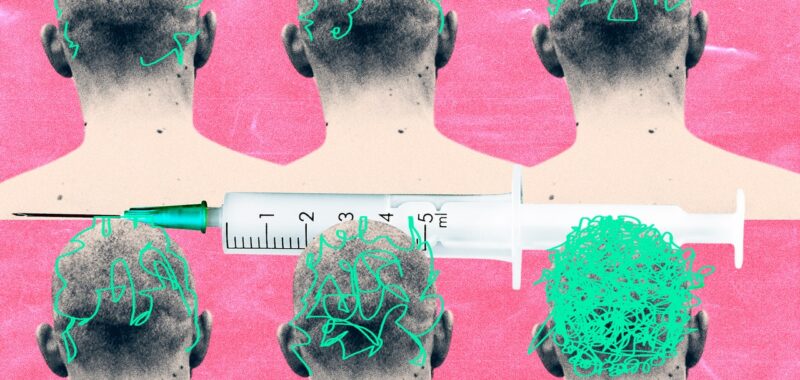Of all the hair loss remedies out there, platelet-rich plasma (PRP) might be the weirdest—at least in terms of delivery. PRP involves injecting your own plasma into your scalp in order to supercharge hair follicles, but its short-term results can make up for that somewhat invasive process.
Plasma injections are not a replacement for the core hair loss treatments—finasteride/dutasteride and minoxidil—says Dr. Benjamin Paul, facial plastic surgeon and hair restoration surgeon at NYC’s Manhattan Surgical Suites. PRP reduces inflammation and fortifies cellular tissue. “Within two weeks of treatment, you will notice a reduction in shedding,” Dr. Paul explains. “And within two months, you will see even more significant improvement, lasting as long as six months [with the most recent advancements].”
In addition to fortifying follicles against androgenetic alopecia (which for men is known as male-pattern hair loss), PRP can also be a terrific one-off solution to telogen effluvium, the often stress-induced shedding of hair that leaves you temporarily sparser than usual.
Read on to learn more about PRP, as well as its more advanced counterpart, PRF, platelet-rich fibrin. (For the sake of simplicity, much of this article is lumping PRP and PRF together as one, and calling them “PRP” collectively, which is common in the industry.)
How PRP Works
PRP works because the plasma in your blood contains platelets, which themselves contain “growth factors” (GFs), proteins which are unique to your DNA. “Growth factors have many roles in the body,” explains Dr. Paul. “They help rejuvenate and heal. The growth factors from our own body are custom to us, so there is very little concern for mismatch or rejection, or for allergic reaction. (Compared to synthesized growth factors or those stem cells extracted from external sources. For example, many topical skincare products promise the sun and the moon with GFs, often in dead-on-arrival snake-oil formulas.)
With PRP, these GFs were in your own blood just 30 minutes prior, and they contain the special sauce that helps supercharge your body’s cellular tissue. GFs can jumpstart miniaturized follicles to produce thicker and stronger strands, thus reducing shedding.
A small group of companies produces the chemical formula that your doctor mixes with the plasma; this solution allows the protein GFs to endure longer term, since a simple injection of standalone plasma would be rendered ineffective rather quickly.
PRP is not just for hair—it is also commonly used to expedite wound repair on bodily injuries, for everything from osteoarthritis to muscle strains to ligament tears.
PRP vs. PRF
There are two primary types of PRP administered for hair loss. In fact, only one is actually called PRP; the other is called PRF (platelet-rich fibrin); it has its own nuances, too, the current premium version of which is called PRFM, short for platelet-rich fibrin matrix. PRF is just an advancement in PRP technology, hence why the classification puts them all under the PRP umbrella.
Standard-fare PRP, the decade-old practice of injecting a plasma solution into the dome, has its drawbacks despite proven efficacy. “With regular PRP, the vascularity washes away soon after injection,” says Paul. “That’s a problem.” Sure, those results will be expressed handsomely in a couple months, but there is so much more potential to extend the longevity of those growth factors. “It is longevity that matters,” Paul says. “Hair grows slowly. If I inject you with PRP today, well, what about the hair growing five or six months from now?”

